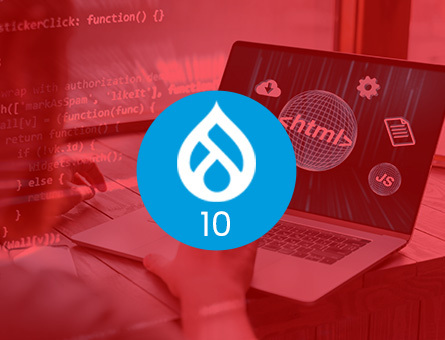Introduction:
In the ever-evolving realm of content management systems, Drupal has consistently maintained its leadership, adapting with each iteration to meet the evolving demands of developers, administrators, and content creators. As the excitement builds for the next significant stride, Drupal 10 emerges as a highly anticipated landmark, poised to deliver fresh features and improvements that will redefine the Drupal experience. With its release intricately tied to Symfony 6 and PHP 8.1, Drupal 10 introduces an array of enhancements that promise to reshape the web development landscape. Let’s delve into the captivating realm of Drupal 10 and explore the transformative additions that revolutionize how websites are built and managed.
Exploring Drupal 10’s Innovations and Improvements:
1. Harnessing Symfony 6 and PHP 8.1: Paving the Path for Progress
At the core of Drupal’s architecture lies Symfony, a framework that dictates the platform’s release timeline. Synergy takes center stage with Drupal 10, Symfony 6, and PHP 8.1. Leaning on Symfony 6, Drupal 10 embraces improved routing mechanisms, refined service management, elevated localization capabilities, and fortified multilingual functionalities. These advancements are seamlessly integrated into Drupal’s development ecosystem, augmenting its efficiency and potency.
2. Elevated Security Features: Safeguarding Digital Frontiers
Security remains a paramount concern for Drupal, and version 10 enhances this aspect significantly. Bolstering the foundation of website security, Drupal 10 introduces robust support for contemporary password security measures. It encompasses adopting cutting-edge hashing algorithms and heightened password storage practices, strengthening websites against evolving cyber threats. Furthermore, Drupal 10 commits to regular security updates to swiftly address emerging vulnerabilities. Notably, post-November 2023, Drupal 9 will halt its update stream, passing the mantle of ongoing support solely to Drupal 10.
3. Enhanced Editing Experience: Unleashing CKEditor 5
User experience takes center stage in Drupal’s evolution. Drupal 10 showcases this dedication through a revamped editing journey—the transition from CKEditor 4 to CKEditor 5 ushers in a new era of content creation. CKEditor 5, built from the ground up, boasts a scalable and extendable architecture that promises an intuitive and seamless user interface. Moreover, a premium iteration offers an experience akin to Google Docs, with real-time collaboration features such as track changes, comments, revision history, and notifications. It amplifies content creation to an unprecedented level of convenience and efficiency.
4. Theme StarterKit: Streamlining Visual Identity Crafting
The visual allure of a website is a pivotal determinant of its success. Recognizing this, Drupal 10 introduces a groundbreaking feature – Theme StarterKit. This ingenious tool serves as a springboard for crafting custom themes that harmonize seamlessly with branding needs. By circumventing the need for outdated core base themes and sub theme creation, the StarterKit simplifies the process of sculpting unique design elements. Users can effortlessly integrate the StarterKit theme into their projects and proceed to personalize it, fostering uniform and visually captivating websites.
5. Modern Administrative Interface: Welcoming Claro
The administrative interface of a CMS is instrumental in its usability and efficiency. While the venerable ‘Seven’ theme served Drupal well, Drupal 10 strides forward with the advent of the Claro administrative theme. Engineered to cater to contemporary sensibilities, Claro presents a user-friendly interface for administrators. Claro is designed with accessibility in mind, ensuring a seamless navigation experience for users with disabilities within the Drupal administration interface.
6. Transitioning from jQuery for Enhanced Front-End Performance
The landscape of web technologies evolves swiftly, and Drupal 10 embraces this progression by gradually shedding reliance on jQuery in favor of native JavaScript. Developers have propelled this transition with a growing inclination toward vanilla JS for event handling and AJAX requests. By diminishing the dependency on jQuery, Drupal 10 optimizes front-end performance, culminating in more agile and responsive websites. This paradigm shift reverberates across contributed modules, marking a stride towards an efficient and future-proof Drupal ecosystem.
7. Automated Updates: A Glimpse into the Future
The horizon holds even more promise for the ease of Drupal maintenance. The forthcoming Automatic Updates initiative aims to simplify the update process for Drupal core. With a one-click update solution, this initiative promises a substantial reduction in manual development efforts. The ultimate result is a trimmed total cost of ownership (TCO) and a more streamlined maintenance process, empowering website administrators to stay current with minimal hassle.
Conclusion
As the countdown to the Drupal 10 release continues, anticipation runs high. With its integration of Symfony 6 and PHP 8.1, heightened security features, revamped editing experiences, innovative theming capabilities, contemporary administrative interfaces, front-end performance optimizations, and the forthcoming automated updates, Drupal 10 is poised to reshape the contours of web development and content management. Stay tuned as we explore each of these remarkable features comprehensively, uncovering the boundless potential that Drupal 10 promises to unleash.





